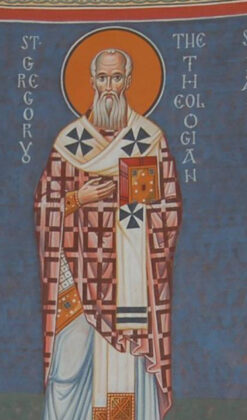
This post is part 3 in my series of responses to Megan DeFranza’s provocative book Sex Difference in Christian Theology. As I said in my first post, this book has been one of the most thought provoking books I’ve read in the past few years and I highly recommended it to anyone interested in a Christian theology of sex and gender.
And just so everyone knows, Megan has begun a series of blogs responding to my posts. If this discussion interests you at all, and since you’re reading this post my guess is that it does, then please be sure to read her responses. They are incredibly thoughtful. I could take the time to respond to her response to my response, and maybe in a future blog I will, but in order to keep the discussion moving along, I want to continue to raise some questions about Megan’s argument.
But first, I want to apologize for something Megan called me out on in her post. She said I wrongfully used “shock tactics” in my last post (e.g. about mentioning her exploration into the possibility of an intersex Christ). And she’s right. While I didn’t intend my statement to shock people away from her argument, it really wasn’t necessary to do a drive-by on what she said without also explaining the context in which she said it. So, it really was a distracting and unnecessary point and I shouldn’t have mentioned it in passing. I’m sorry Megan for blogging with my gloves off. I’ll keep it clean from here on out. Or, at least I’ll try 😉
I want to jump back in to Megan’s argument that the binary model of human sexuality—we’re all created either male or female—doesn’t account for the presence of intersex people. What I love about Megan’s book is that she constantly goes back to Scripture and brings it into conversation with Christian theologians both old and new. One of her greatest challenges, of course, is the creation account of Genesis 1 and 2 where Adam and Eve are created as male and female. Doesn’t this creation account clearly support and promote the binary model? Aren’t all humans created either male or female, just like Adam and Eve?
No. Actually they are not, argues Megan. “Adam and Eve, in their sexual difference, function as progenitors rather than paradigms of human difference-in-relation” (p. 287, summing up ch. 4). Do you see Megan’s point? She argues that the sexual difference of Adam and Eve were necessary to get the human race going (e.g. through procreation) but that they weren’t intended, as male and female, to be the paradigm of how all future humans would be exist. Adam and Eve “inaugurate the story of God’s redemptive work, which begins with a biological family but presses beyond biology to include other others in the family of God” (p. 287).
Now, you may disagree and think this is all a bunch of rubbish. But disagreement isn’t refutation. You must show why and where Megan is wrong if you disagree. And quite frankly, she raises some really fascinating points.
For instance, she rightly acknowledges that the categories of male and female in Genesis 1 are part of the texture of creational complementarity: land and sea, light and darkness, male and female. But Genesis 1 “does not list other forms or mixed forms regularly seen in creation: rivers, asteroids, planets, amphibians, dusk, dawn, etc. Few would argue that these ‘others’ or ‘hybrids’ are a result of the Fall, or that they stray from God’s creation intent.” Likewise, the categories of male and female are what my friend Roy Ciampa (an accomplished NT scholar) calls “minimalistic binaries,” or ends of a spectrum that leaves room for some “in-between-ness.”
Quick rabbit trail, I had a conversation with Roy about these “minimalistic binaries” about a year ago and my mind has been spinning ever since. If the pre-fall creation contained day and night, yet also contained dusk and dawn—neither day nor night—could it be that the creation of humanity as male and female might also have included intersex people who are neither male nor female? You’ve got to stuff this in your pipe and smoke it for a while. Savor its flavor. Let it linger on your toungue. It’s a fascinating point that I haven’t heard anyone else bring up.
What’s funny is that according to page 177 of Megan’s book, she had the same conversation with Roy as well! Thanks Roy for messing with our minds and wrecking our neatly packaged view of Genesis 1.
I’ll come back to the whole dusk and dawn pre-fall “hybrid” thing in a second. But I want to address—and challenge—Megan’s point about Adam and Eve not being a paradigm for sexual difference. I was waiting for how Megan was going to handle Matthew 19, 1 Timothy 3, and other passages where Jesus and the NT writers do see Adam and Eve’s sexual difference as a paradigm for some sort of sex difference in human relations. For instance, Jesus says: “Have you not read that from the beginning the Creator made them male and female…?” (Matt 19:4). Sure seems like Jesus saw the sexual difference of Adam and Eve to be paradigmatic of what constitutes marriage. Paul takes it a different direction in 1 Timothy 3, but he also seems to see the sex difference of Adam and Eve as comprising a paradigm for how sexual humans should function. So how does Megan address this?
She doesn’t. She doesn’t mention the New Testament passages that certainly appear to treat the creation account of sexual difference as normative. (She mentions Matt 19 in the context of her discussion of Pope John Paul II [p. 159] but not in the context of her section on Adam and Eve as progenitor not paradigm [pp. 175-184].) So I don’t think it’s an either/or situation—either Adam and Eve are progenitors of the human race or they are a paradigm of sexual difference. I think they’re both. And the New Testament seems to confirm my suspicion. (Sex difference appears to linger behind Paul’s argument in Rom 1:24-27 as well.)
Okay, so back to our dusk and dawn question. Does Genesis 1-2 demand a male/female binary?Or does it allow for pre-fall sexual “hybrids” that break free from the male/female binary?

Despite Roy and Megan’s argument, I’m still not persuaded. While Scripture itself will later testify to the existence of other creational hybrids such as dusk and dawn and marshes and amphibians, the Bible itself never explores human categories of sexual “in-between-ness.” That is, sexual hybrids (intersex people) were known to the ancient writers, yet they were never taken up in the Scriptural narrative in a way that challenges the male/female binary. You may say, “oh, that’s just a naïve argument from silence.” And maybe it is. But I would guess that a theological topic as important as human nature would get some biblical airtime if male and female weren’t the only two options. Why would the Creator’s revelation to human kind pass over such a fundamental point about human nature? As it stands, though, the male and female binary is maintained with striking consistency in the Biblical narrative—even though its writers were well aware of sexual others (e.g. intersex or “hermaphrodites”) that could challenge that model.
Could it be that intersex people are, like all of us, affected by the Fall? Does the Fall touch every aspect of our human nature except our sexual anatomy? And is there evidence that this aspect of our humanity is immune? Megan seems to say that the Fall is a lame explanation for intersex difference. Let’s go there in the next post.











